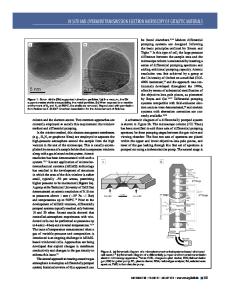In situ transmission electron microscopy of nano-sized metal clusters
- PDF / 5,326,285 Bytes
- 10 Pages / 596 x 842 pts (A4) Page_size
- 65 Downloads / 469 Views
P7.4.1
In situ transmission electron microscopy of nano -sized metal clusters
Jeff Th. M. De Hosson, George Palasantzas, Tomas Vystavel, Siete Koch Dept. of Applied Physics, Materials Science Centre and the Netherlands Institute for Metals Research, University of Groningen, Nijenborgh 4, 9747 AG Groningen, The Netherlands. ABSTRACT The paper concentrates on in situ transmission electron microscopy of nano -sized Mo and Nb clusters. In particular, this contribution presents challenges to control the microstructure in nanostructured materials via a relatively new approach, i.e. using a so-called nanocluster source. An important aspect is that the cluster size distribution is monodisperse and that the kinetic energy of the clusters during deposition can be varied. The deposited Mo clusters with sizes 5 nm or larger show a body-centered crystal (bcc) structure. The cubic clusters are self-assembled from smaller ones and forming distorted cubes of typical size 7.8 nm or larger. With reducing cluster size to ≤3 nm, the face centered crystal (fcc) structure appears due to dominance of surface energy minimization, while self-assembly into large cubes with sizes up to 20 nm is still observed. In situ TEM annealing leads to cluster coalescence at temperatures ∼800 °C, with the crystal habit changing to rhombic dodecahedron for isolated clusters, while large cubes change to faceted polyhedra. In situ TEM annealing studies on Nb clusters showed that cluster coalescence events were not observed even at rather elevated temperatures because of the formation of oxides. INTRODUCTION Materials built up from nanostructure constituents can have properties fundamentally different from conventional materials. Nevertheless, in evaluating the performance of a nano-structured material it is essential to examine the defect content as well as the microstructural features, in particular: grain size dispersion, distribution of interface misorientation angles, and internal strains. Clearly, defects, such as microcracks, can completely mask the intrinsic strength of the nano-structured materials. In the past the low E- modulus of nano-structured materials has been often attributed to the unusual grain-boundary structures present but this phenomenon is actually determined by the defect structure, lik e porosity. Further, it can be anticipated that control of the grain-size dispersion is extremely important in the experimental design of these nano-structured materials. A nano -structured material with a broad grain-size dispersion will exhibit a lower overall flow stress than a material with the same average grain size but with a much smaller grain-size distribution. Consequently, experimental control over the grain-size distribution is important to investigate concepts in materials design of nano-structured materials . Although the structural studies on metal clusters with the cluster size 10 eV/atom) [3]. The low and medium energy deposition produces films with clusters that stay rather intact upon impact. However, these films are porous (prese
Data Loading...











